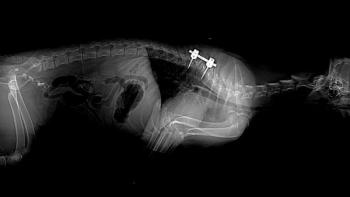
Stroke: CNS vascular diseases (Proceedings)
The brain is an extremely well vascularized organ and is supplied by approximately 15-20% of the total blood flow of the body. This high requirement for blood is necessitated by the brain's high metabolic activity and corresponding need for oxygen and glucose to fuel this activity.
Disease etiologies
The brain is an extremely well vascularized organ and is supplied by approximately 15-20% of the total blood flow of the body. This high requirement for blood is necessitated by the brain's high metabolic activity and corresponding need for oxygen and glucose to fuel this activity. A "stroke" is a sudden, focal neurologic deficit resulting from a cerebrovascular accident. Stroke is an extremely important disease process in humans, affecting large numbers of people every year, and leading to considerable morbidity and mortality. The importance of stroke in veterinary patients has been downplayed in the past, but is now being recognized with increasing frequency, thanks mainly to advances in diagnostic imaging.
Vascular disease of the central nervous system (CNS) comprises a number of disease entities, which may be divided into two main categories: ischemic events and hemorrhage. Ischemia may be global in nature (e.g. anesthetic accidents) or focal, secondary to vessel occlusion from a thrombus, embolus or other process. A thrombus is a localized obstruction of flow, typically from the formation of a blood clot, while an embolus is formed at a remote location, and travels through the bloodstream, eventually lodging in a small diameter vessel. Severe ischemia results in the death of a well-circumscribed area of the nervous system, producing an infarct. Hemorrhage occurs due to rupture of a blood vessel within the brain parenchyma or within an associated pathologic lesion, and may have a number of underlying causes.
Etiologies of CNS ischemia
Global
• Anesthetic accidents
• Cardiovascular arrest
Local
• Thrombosis
Coagulopathies (Hyperadrenocorticism, chronic renal disease)
o Vasculitis
o Neoplasia
o Trauma
o Atherosclerosis (hypothyroidism, hyperlipoproteinemia)
• Embolism
o Heart disease
o Heartworm disease
o Sepsis
o Neoplasia
o Fibrocartilagenous embolism (spinal cord)
• Other Occlusive Disease
o Vasculitis
o Transient ischemic attacks?
Etiologies of CNS hemorrhage
• Hypertension
• Hemorrhagic infarction (typically venous)
• Vasculitis
• Cerebral amyloid angiopathy
• Coagulopathies (Rodenticide intoxication, congenital deficiencies, Angiostrongylus vasorum infection)
• Vascular malformations
• Neoplasia
Anatomy, physiology and classification of disease
The brain is supplied by an extensive vascular network, which varies somewhat between species. In the dog, as in humans, the two main arterial sources of blood to the brain are the internal carotid and basilar arteries. These feed into the arterial circle surrounding the hypothalamus (Circle of Willis) from which the cerebral and cerebellar arteries supplying the majority of the brain parenchyma arise. These include the rostral, middle and caudal cerebral arteries that supply the cerebral cortex, and the rostral cerebellar artery supplying the cerebellum. The caudal cerebellar artery arises directly from the basilar artery. Smaller striate arteries supply the deeper gray matter structures of the basal nuclei (e.g. caudate nucleus, globus pallidus, putamen), while various perforating arteries supply the thalamus and midbrain. The cat is similar, except that the main source to the Circle of Willis is the maxillary artery, and blood flow in the basilar artery is cranial to caudal in this species.
The spinal cord has several sources of arterial blood, including the ventral spinal artery, which becomes the basilar artery rostrally, and is supplied by segmental arteries connecting to the large vertebral arteries on either side. In addition, paired spinal arteries arise from the aorta at each vertebral segment to supply the spinal cord. These feed into an extensive anastamotic network around the cord, which supply small vertical and radial arteries that enter the spinal cord parenchyma.
Infarction occurs when ischemia leads to the necrotic death of neurons and glial cells. Infarcts have been classified as territorial, affecting large-diameter vessels, or lacunar, which affect smaller penetrating arteries. Transient ischemic attacks (TIA) are well-recognized events in humans, defined by focal neurologic deficits secondary to vascular constriction, spasm or temporary occlusion that resolve within 24 hours. Although poorly documented, many veterinary neurologists believe that similar attacks occur in dogs, and may precede a more severe ischemic event.
Signalment, history and examination
There are certain clinical hallmarks of vascular disease that characterize it from other disease processes. These diseases have a very acute onset of signs with little progression after the initial event. Signs are often asymmetrical in nature, predominating on one side of the body, and the absence of pain or discomfort is also typical. Careful questioning of the owner and results of the neurologic examination should reveal these characteristic changes. Dogs with fibrocartilagenous embolization (FCE) of the spinal cord often have a period of vigorous activity just preceding the onset of clinical signs.
Physical examination may reveal signs of medical conditions predisposing the patient to vascular disease such as hyperadrenocorticism, hypothyroidism, heart disease, hepatic disease, chronic renal failure or neoplasia. The retina should be examined for evidence of hemorrhage, which might be seen with hypertension.
Neurologic examination findings will depend on the location of the insult. Common locations are the cerebral cortex, cerebellum, thalamus, basal nuclei and lumbar intumescence of the spinal cord. Animals with a cortical or basal nuclei lesion will often circle towards the side of the lesion. Seizures, behavioral changes, hemi-inattention, cortical blindness and contralateral conscious proprioceptive (CP) deficits may be seen. Animals with cerebellar lesions will often be ataxic with hypermetria and possibly intention tremors, nystagmus, head tilt or opisthotonus. Thalamic lesions may cause a head turn or tilt, postural reaction deficits and nystagmus. Disease involving the brainstem may show focal cranial nerve deficits depending on the specific location. FCE typically presents as an acute asymmetric paraparesis or paraplegia.
Some breeds may be predisposed to vascular disease of the CNS, including the greyhound. The cause for this is unknown, but may be related to hypertension or an underlying platelet dysfunction. FCE tends to occur in large-breed dogs and miniature Schnauzers.
Diagnostic plan
Initial diagnostic tests to consider will depend on the results of the physical and neurologic examinations. Complete blood count, serum biochemical analysis and urinalysis may be suggestive of underlying diseases responsible for systemic vascular disease, such as chronic renal failure or hyperadrenocorticism and are indicated before anesthesia for advanced diagnostics. Thoracic and abdominal imaging may be considered to evaluate for heart, hepatic or renal disease and neoplasia. Specific tests for hyperadrenocorticism, hypothyroidism, liver function, coagulopathies, heartworm disease and gastrointestinal parasitism may also be considered. Blood pressure should be evaluated.
The cornerstone of diagnosis of CNS vascular disease is diagnostic imaging. Magnetic resonance imaging (MRI) is particularly valuable in this regard, although computed tomography (CT) can be useful in some cases. Ischemic lesions are hypointense on T1-weighted and hyperintense on T2-weighted MRI images and occur in regions supplied by specific arteries described above. These lesions are well demarcated, and often have a triangular or wedge-shaped appearance. These lesions are usually hypodense on CT. Enhancement is usually not seen after intravenous contrast administration until the lesion is several days old.
Hemorrhage has a very complex appearance on MR images, which changes over time. Large hemorrhages usually have a heterogeneous signal with regions of hyper- and hypointensity corresponding to different oxidized forms of hemoglobin within the lesion. Acute hemorrhage is often hyperdense on CT images. Some small lesions may be difficult to see with conventional MR or CT imaging, and specialized sequences, such as FLAIR, gradient echo and diffusion-weighted protocols, may increase sensitivity.
In dogs with suspected FCE, imaging of the spinal cord is usually indicated. MRI is ideal, and shows ischemic changes as described above, with accompanying spinal cord edema. In some cases, MRI is not available and myelography is performed, which is usually normal or shows swelling of the spinal cord in the affected region.
Cerebrospinal fluid (CSF) evaluation is not always required, but may be helpful in some cases to eliminate other differential diagnoses, such as meningoencephalitis. Animals with vascular disease of the CNS may have normal CSF or may show an elevated protein level or a mild pleocytosis. In some cases of hemorrhage, the CSF may be overtly hemorrhagic or xanthochromic (yellow), and red blood cells may be seen cytologically (free or phagocytosed by macrophages).
Treatment plan
The treatment plan should address any underlying etiology, if present. This may include medications for hypertension, heart disease, hyperadrenocorticism, hypothyroidism or coagulopathies, or other definitive therapies for neoplastic or renal disease. Therapy for the central nervous system lesion itself is largely supportive in nature. Cerebral edema may be improved in some cases with glucocorticoid therapy. In cases with marked cerebral edema and increases in intracranial pressure, mannitol therapy with or without furosemide or hypertonic saline may also be considered. Maintaining a normal blood pressure and ensuring adequate oxygen delivery to the brain and central nervous system are essential to prevent further tissue damage and promote recovery. Seizures or other neurologic sequelae should be addressed appropriately (e.g. anticonvulsant medications). General fluid therapy and nursing care consisting of frequent turning if recumbent, bladder management and physiotherapy are also important. The most important aspect of therapy is time, as most animals will improve over time if given the chance.
Prognosis
Although often extremely debilitating in humans, stroke in veterinary patients usually carries a favorable prognosis. Most animals will improve markedly with time, even if they are very severely affected at presentation. This species discrepancy is likely related to the fact that dogs and cats are much less reliant on cortical pathways for ambulation and tasks requiring higher function are less critical. Animals with FCE usually also improve with time, although residual deficits (e.g. loss of conscious proprioception or altered gait) are sometimes seen. Depending on the underlying etiology, some animals may be at risk for recurrent vascular events, and owners should be advised accordingly.
Newsletter
From exam room tips to practice management insights, get trusted veterinary news delivered straight to your inbox—subscribe to dvm360.




